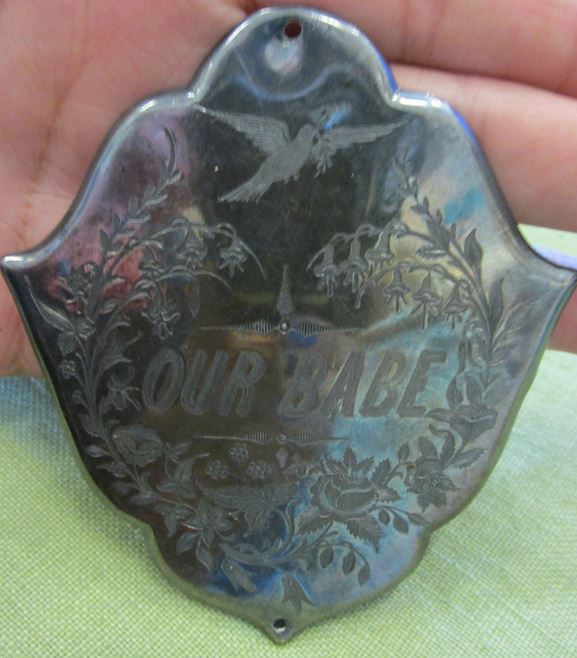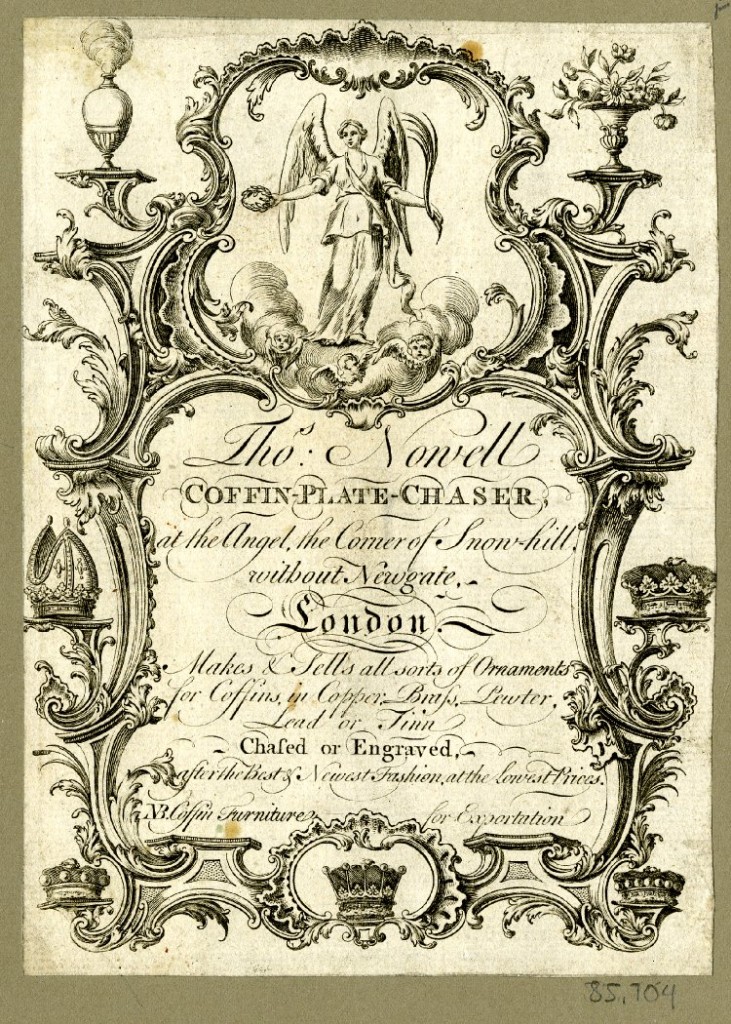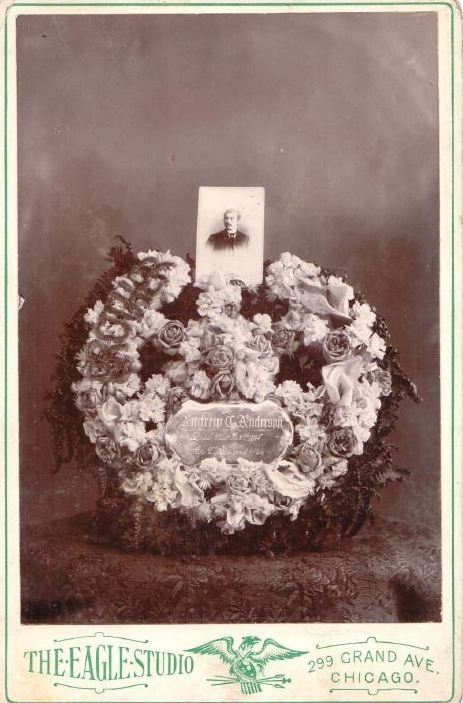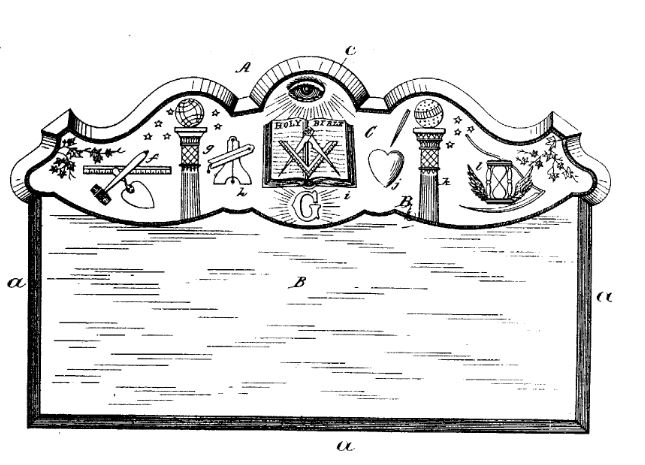The Last Word: Coffin-Plate Capers
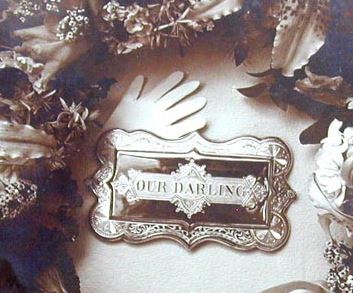
Coffin plate photographed with wreath. See below for full image.
I once bought an “Our Darling” coffin plate (in original box) as a birthday present for a friend who collects post-mortem photographs. It was in beautiful condition and the box offered reassurance that this was new-old stock, literally, “deadstock” rather than resurrected grave-goods. All the same, the birthday girl eventually got rid of it, saying that there was “something,” “attached” to it.
Many of our ancestors had no compunction in keeping coffin-plates taken directly from a coffin as a memento of a loved one. The plates, which might be made of many different types of cast or hammered metal such as brass, polished tin, pewter, silver-plate and even solid silver, were engraved with the name and dates of the deceased and sometimes with an emblem or short motto like “Baby” or “At Rest.” The inscriptions were almost always reported in newspaper reports of the funerals of the good and the great. The plate might be left on the coffin, to be buried, or might be removed by the undertaker before the burial and given to the family.
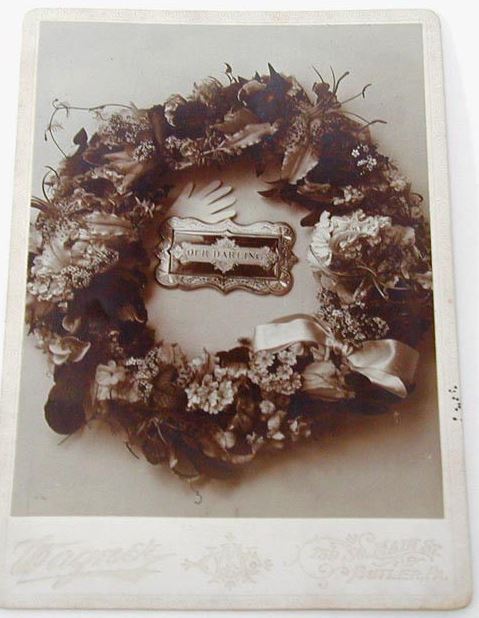
http://www.ebay.com/itm/Victorian-Mourning-Cabinet-Photo-Wreath-Traced-Hand-Our-Darling-Butler-PA/161820266876?_trksid=p2047675.c100011.m1850&_trkparms=aid%3D222007%26algo%3DSIC.MBE%26ao%3D1%26asc%3D20140602152332%26meid%3D2ed867ee2db14b2ba56e6bf9c2e67f60%26pid%3D100011%26rk%3D2%26rkt%3D2%26sd%3D251797176118
He had the coffin-plate framed, resting gruesomely on a bed of black velvet, and hung it against the wall in the moldy-smelling best room. Frequently, as he was about to retire, he went creaking in, shielding the lamp with his palm to gaze on the relic and sigh a mournful sigh… [tells the visiting parson;] “I ordered extry-coated plate so I can scour when it gits tarnished.” “Mournful” Mullen, Holman F. Day. Our Paper, Massachusetts Reformatory, 26 January, 1907
Alternatively a duplicate coffin plate might be engraved as a memento, or, as in the case of those discarded veterans’ tombstones, so recently in the news, a defective coffin-plate might end up in the wrong place, causing no end of trouble.
UNDERTAKER EXPLAINS COFFIN-PLATE MYSTERY
Mr. Schilling Says Two Plates Were Made, One Being Defective—Body to Be Exhumed.
The mystery surrounding the finding on a vacant lot in Northeast Baltimore of a coffin plate bearing the name of Conrad Kraft was cleared up yesterday afternoon. Undertaker George Schilling, Alsquith and Monument streets, reported to Lieutenant Wellener, of the Northeastern Police Station, that while the plate for the coffin was being engraved a mistake was made in the figure 3. It was not until the plate had been placed on the coffin that the defect was noticed, and the family ordered it to be removed. This Mr. Schilling did, replacing it with a perfect one. The defective plate was returned to the workshop and thrown among a lot of rubbish. Here is remained until last Friday, when it was removed to the “dump” with other refuse by one of Mr. Schilling’s employes. As Mr. William H. Watts was walking across the dump to his home he noticed the plate shining out from a lot of other stuff, and after reading the inscription took it to the Northeastern Police Station.
Mr. Schilling noticed the account of the finding of the plate in The American, and visited Mrs. Kraft and explained the circumstances in which it was lost. Mrs. Kraft did not seem to be perfectly satisfied, and yesterday stated that she would have the body exhumed. Baltimore [MD] American 28 November 1903: p. 16
“Our Babe” coffin plate. http://www.ebay.com/itm/RARE-Antique-Victorian-Funeral-Coffin-Casket-OUR-BABE-Silver-Plate-Plaque-/311420971897?
There was a certain amount of controversy about the taste and propriety of displaying a family coffin plate. In the early 1900s it was seen as a nearly obsolete article of mourning apparatus and, at least in popular fiction, a description of a framed coffin plate (on a black velvet background) signaled to the reader that the story was set in an old-fashioned or rural home. The custom seems to have lingered on in the United States primarily on the East Coast or New England states. This story is from a New York home.
“That’s the plate,” explained the laundress.
“But I thought,” said the visitor, “that coffin plates should be left on for—“ She was going to say “for purposes of identification,” but thought better of it.
“Most people do leave ‘em on,” explained the proud possessor, “but it was so pretty, I wanted it. I’m going to have it framed in one of them deep frames soon as I can afford it, and hang it in the parlor. It’ll be awful pretty. I want a wreath of white roses set about it, an’ a big black velvet bow put at the bottom of the wreath.” Jonesboro [AR] Evening Sun 10 January 1905: p. 2
A trade card for a chaser of coffin plates. http://www.britishmuseum.org/research/collection_online/collection_object_details.aspx?objectId=3056672&partId=1&searchText=coffin&images=true&page=1
COFFIN PLATES
A sign is conspicuously displayed on one of the principal streets of this city bearing the announcement, “Coffin Plates Framed Here.” Pray tell us, Mr. Editor, what you would do with a framed coffin plate. Lowell [MA] Daily Citizen and News 23 June 1874: p. 2
Some suggested that the practice of keeping a coffin plate was too morbid to countenance.
“How about photographing the dead?” “We discourage it altogether. It is a ghastly process, and is suggested by minds insane with grief. It would be just as wise to keep the coffin plate or a bit of the shroud as a memento of those who are gone. The Boston [MA] Weekly Globe 26 June 1883: p. 6
And doctors had to be particularly sensitive about such décor.
There is another so-called ornament that has been seen in a country doctor’s office; it is that awful reminder of death that adorns the grim and somber, dank and chilly country parlor or best room too good for daily use. It consists of a black glazed frame in which the coffin-plate of some deceased relative is conspicuously displayed on a black ground surrounded with stiff wax flowers. The very thought of it suggests wailing and gnashing of teeth, and it’s too funereal an object for the doctor’s use. One might just as well go the whole figure and set up a coffin, Chineselike, in the corner, or keep a stock of coffins on hand, to be thrown in as a premium, to soothe the feelings of the afflicted, in case the doctor isn’t successful in snatching a victim from the grasp of death. Besides, a coffin-plate is a sort of card of introduction to whom it may concern, in the hereafter, and to take it from the coffin, is, in a sense, a sacrilege, a deprivation of rights. “Medical Bricabracology,” Leon Noel, The Philadelphia Medical Journal, Vol. 4, 2 September, 1899
This 1905 article describes the custom as something eccentric and quaint.
GLOOMY BRIC-A-BRAC
Coffin Plates Once Used as House Ornaments in Maine.
In New England 100 years ago it was by no means uncommon for people to provide their coffins long before their death and keep the same in their houses, where they could see them every day. It was perhaps a custom having the same purpose and significance as the skeleton at the feasts of the ancient Greeks, to remind the living in their hours of levity of the seriousness of life and the certainty of death.
This was not the idea, however, of a man named Lindsey, whom people now living in Leeds may remember or at least have heard of. He built his own coffin many years before he died and used to keep it in a chamber of his house. He used it generally to keep beans in. It was a very find coffin, made of mahogany and nicely finished and polished. Mr. Lindsey made it with his own hands and gave as reason that if he left the task of providing him with a coffin to his sons it would be just like them to put him in a hemlock one. Perhaps the boys did not relish the implication. At any rate, they did not like to have the coffin about the house and took it away one night and threw it into the river. It was found several miles below, considerably broken and battered as it went over the rips, and old Lindsey heard about it, drove down and got it and was finally buried in it.
Another queer custom that prevailed in this section of Maine down to a comparatively recent date was that of removing the plate for the coffin after the funeral and just before the body was lowered into the grave and keeping it in the best room in the house among the ornaments and bric-a-brac. The writers saw one of these grewsome exhibits on the mantel of a Lincolnville parlor not more than twenty-five years ago, and we shouldn’t be surprised if quite a number of them could be found in the old houses throughout Maine. Bangor News. Prescott [AZ] Morning Courier 2 May 1905: p.1
Funeral wreath for “Brother” with coffin plate and photo of deceased. Private Collection
But coffin plates could also be functional as well as decorative. They provided proof of relationships and might be used as an informal type of death certificate.
OFFERS COFFIN PLATE AS EVIDENCE HE IS WIDOWER
Providence Man Astonishes Immigration Board.
Does a coffin plate constitute conclusive proof that Philip O. Turcone is a widower?
Turcone evidently believes the plate made a profound impression yesterday when he fished it from his clothes in presence of a board of penal inquiry at the immigration station. He had come from Providence, where he is employed as a carpenter, to claim Raffaela Pirone as his intended bride. The girl arrived from Italy on the Cretic a few days ago and had been detained on a medical certificate as afflicted with a disease of the eye. When the board interrogated Turcone he said he was a widower. The board asked for proof that his wife is dead and he flashed the coffin plate before their astonished gaze with the statement that he is an advocate of preparedness.
Miss Pirone’s case is one that usually gets a deportation order from Washington because her physical affliction is ordinarily contagious. She will appear, however, and Turcone stands ready to pay expense of hospital treatment. Boston [MA] Herald 27 October 1915: p. 9
Many coffin plates were rather substantial, so it took a special kind of resolve to carry one to court in one’s stocking.
USES COFFIN PLATE TO PROVE HIS DEATH
Colored Woman Takes It From Her Stocking for Evidence in Probate Court
New Haven, Jan. 27. A nickel coffin plate from her husband’s coffin was the novel proof of his death, submitted by the widow, Mrs. Joseph Trent, colored, in the local Probate Court today. Trent died recently in New York, leaving real estate in this city. The widow appeared in the court today, and after expressing her wish to probate the estate here, pulled a marriage certificate from her pocket, exclaiming, “This shows you that I was married to him.”
Then, producing the nickel coffin plate, which she took from her stocking, she continued, “This shows you my husband is dead.”
The evidence was accepted and her application placed on file. Boston [MA] Journal 28 January 1910: p. 3
An 1884 coffin plate designed for a Mason.
For this family with the custom of collecting coffin plates, the mementos were cherished for the tale they told of a long and distinguished lineage.
COFFIN PLATES IN THE PARLOR
A QUEER CUSTOM LIKELY TO SURPRISE STRANGERS TO CONNECTICUT HOUSEHOLDS
Milford, Sept. 16, 1889. A stranger calling at the residence of Mr. Thaddeus Smith, on Brad street, one of the oldest and most respected inhabitants of Milford, is likely to be surprised while sitting in the parlor to see a queer oblong silver plate lying on the centre table. At first the caller may think it is a door plate. On closer inspection he will find that is bears an inscription to the memory of the venerable Mr. Smith’s daughter, and is nothing less than a silver coffin plate. It lies on the stand among hymn books, photographs albums, card cases and other drawing room trinkets. None of the Smith family ever refers to it unless the subject is mentioned by a caller. Then they describe, in tones of affectionate tenderness, the many virtues of the daughter that was so dear to them. The coffin plate occupies in that household much the same place of veneration that an urn with the ashes of the dead holds in the houses of the advocates of cremation.
Singular as the custom may seem, there are many New England homes, especially in this part of Connecticut, where coffin plates of dead relatives or cherished friends are kept as mantelpiece ornaments or on the centre tables in the parlor. One family in New Milford is said to have a collection of no less than fourteen brass, silver, and plated relics taken from the coffins of dead members of the family, reaching down to within fifty years of the founding of the colony two centuries and a half ago. The oldest of this rare collection of coffin plates bears the name and date of the birth and death of one of the original settlers of New Haven colony. It is black and discoloured by the lapse of time, but the family would as soon think of parting with it as they would of losing the family Bible, which contains the genealogical records of the entire race.
An amusing story is told about the coffin plates collected by a Stratford family. There were nine or ten of them in places of honor about the parlor of the old-fashioned farmhouse. Some years ago an irreverent burglar entered the house at night, and seeing the glittering mementos of the dead decorating prominent pieces of furniture in the room dumped them all into his booty bag, and together with the silver knives and forks and what other portable household effects he could conveniently carry, made his exit unmolested. Great was the consternation of the easy going farmer and his family when they awoke the next morning to find that their dining room silverware had been carried off, but they were shocked beyond expression when they discovered the rape of the coffin plates, which could not be replaced at any cost.
They were proportionately gratified a day or two later to receive a box by express, in which were packed all the missing coffin plates. With it was a note in a rough hand, which said.
“Here is your coffin signboards. I have found they wasn’t much but German silver in them, and that ain’t my line. You’re welcome to ‘em, and thanks for your silver in spoons, which I’ll keep. Merry Christmas.” New York [NY] Herald 18 September 1889: p. 13
Coffin plates were considered by some to be a sacred relic. Hence the outrage at this miserly widower:
Another instance of this despicable quality [meanness], bordering on sacrilege, has been told to us. A man who had just married his second wife, and was brushing up his house, so as to have it in keeping with such an event, took the coffin-plate of his wife to an engraver, and wanted to know how much it would cost to erase the inscription thereon, and put in its place his own name, so that he might use it for a door-plate. The original cost of the plate, inscription and all did not exceed one dollar! This is an actual fact; and all the parties reside in Springfield. Springfield Republican. Main Cultivator and Hallowell [ME] Gazette 13 February 1847: p. 1
Strangely, coffin plates were occasionally used as a forum for protest. For example, William Abson, who was accused of poisoning his wife, killed himself in prison, leaving instructions that on his coffin plate should be inscribed: “I am innocent of that for which I lose my life.” New York Herald 23 March 1861: p. 8
The Charles Becker case , where a former police Lieutenant was convicted and executed for the murder of gambler Herman Rosenthal, was one of the most notorious examples of getting the last word:
Becker “Murdered,” Says Coffin Plate
Widow of Ex-Lieutenant Puts Blame on Whiteman
Latter Doesn’t Believe the Story.
New York, Aug. 1. A silver plate bearing the inscription “Charles Becker, Murdered July 30, 1915, by Governor Whitman,” was placed tonight on the coffin containing Becker’s body, by direction of his widow. The plate is four by seven inches in size and the letters in script are an inch high. It is securely fastened. Becker’s body is to be buried tomorrow.
He Doesn’t Believe it.
Albany, N.Y., Aug. 1. “I cannot believe it,” was Governor Whitman’s sole remark tonight when told of the plate on Charles Becker’s coffin.
Plate Removed.
New York, Aug. 1. The police, it was announced tonight, had had removed from the coffin of Charles Becker a silver plate placed there by his widow on which was inscribed the charged that the former police lieutenant, electrocuted Friday, was “murdered by Governor Whiteman.” Mrs. Becker was informed that the inscription was a criminal libel on the governor and was prevailed on to permit its removal. Macon [GA] Telegraph 2 August 1915: p. 6
The coffin plate also had a more discreet function: to ensure the safety of graveyard personnel.
A CURIOUS FACT
In leaden coffins it is customary to make a number of holes, underneath the coffin plate, to give egress to the gases, which would else, by their accumulation, first bulge and then burst the coffin. When this precaution is neglected, considerable danger ensues to the grave diggers, who have on many occasions been seized with asphyxia, or even killed on the spot, by the poisonous gases emitted from a suddenly burst coffin. To escape these hazards, they not unfrequently ‘tap’ the coffins, and let out a jet of gas, which being ignited, burns from ten minutes to half an hour. Schenectady [NY] Reflector 8 February 1850: p. 6
Has anyone ever seen evidence for this illuminating practice, like scorch marks on old lead coffins? Could such gases be harnessed today as a source of energy?
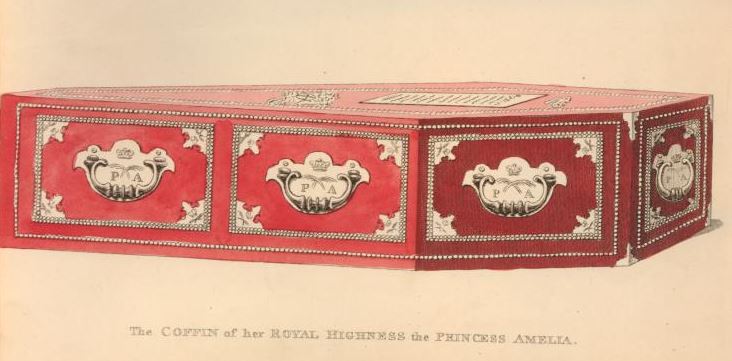
The Coffin of HRH Princess Amelia, showing the beautiful coffin furniture, including a coffin plate. http://www.britishmuseum.org/research/collection_online/collection_object_details/collection_image_gallery.aspx?assetId=1612960923&objectId=3587418&partId=1
And, finally, just as visions of tombstones and phantom funerals presaged death, so did dreams and visions of highly-specific coffin plates.
A Cincinnatian dreamed three years ago of seeing a friend’s funeral, and that friend has since drank himself to death with cheerful regularity, dying on the date seen on the coffin-plate of the vision. This they call a prophecy, out there. Jackson [MI] Citizen 26 July 1870: p. 5
And this, from England:
SINGULAR STORY.
The death of Mr. F. H. Wiggin, proprietor of the Northumberland Arms, Bermondsey, took place on Thursday morning, the 8th inst. Mr. Wiggin retired to bed the previous night in his usual health and spirits, but at 5 o’clock in the morning he ruptured a blood-vessel, and in six hours he expired from exhaustion. It seems a remarkable presentiment of his death was made known to him two months previously, when, to amuse his children, he drew upon a slate a coffin, and wrote an inscription, a verbatim copy of which was inscribed on his coffin plate on his interment, as follows:—”Frederick H. Wiggin, died October 8th, 1868, aged 40.” This sketch and inscription he showed to his wife, and others who happened to be present. The remains of the deceased, who was much respected, were, on Monday, taken from London to Horton, for interment by the side of his father’s grave.—Daily News, 19 October. The Spiritual Magazine, Vol. III, 1 November, 1868
Have you ever seen a coffin plate? Or framed one as a parlor ornament? chriswoodyard8 AT gmail.com
Chris Woodyard is the author of The Victorian Book of the Dead, The Ghost Wore Black, The Headless Horror, The Face in the Window, and the 7-volume Haunted Ohio series. She is also the chronicler of the adventures of that amiable murderess Mrs Daffodil in A Spot of Bother: Four Macabre Tales. The books are available in paperback and for Kindle. Indexes and fact sheets for all of these books may be found by searching hauntedohiobooks.com. Join her on FB at Haunted Ohio by Chris Woodyard or The Victorian Book of the Dead.

